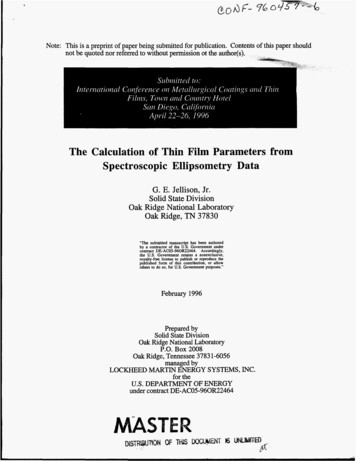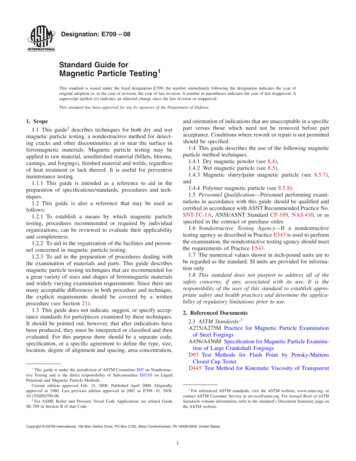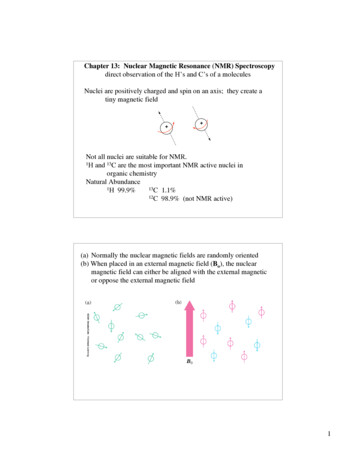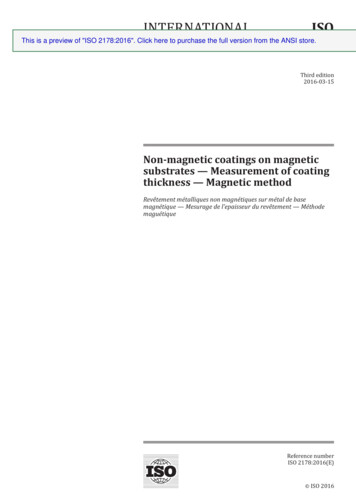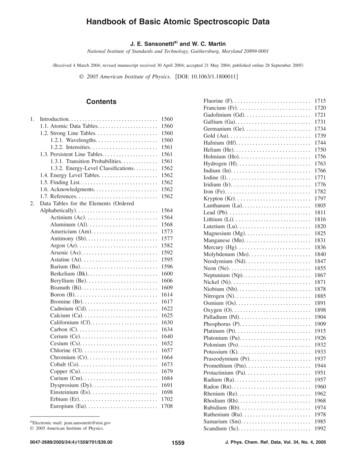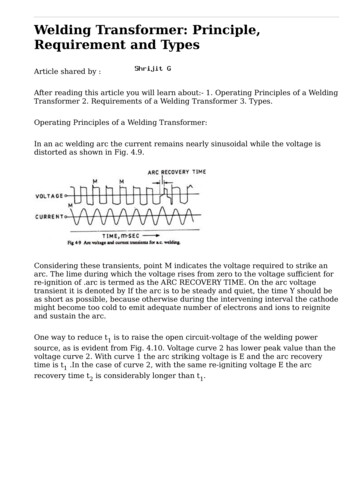
Transcription
ETH LibraryMagnetic and spectroscopicinvestigations of mineraltransformations in mixed-valenceoxides and magnesium silicatesDoctoral ThesisAuthor(s):Fischer, HåkonPublication date:2008Permanent s / license:In Copyright - Non-Commercial Use PermittedThis page was generated automatically upon download from the ETH Zurich Research Collection.For more information, please consult the Terms of use.
Diss.ETH n 17774Magnetic and spectroscopic investigations of mineraltransformations in mixed-valence oxides and magnesiumsilicatesA dissertation submitted to theSwiss Federal Institute of Technology, ZürichFor the degree ofDoctor of SciencesPresented byHÅKON FISCHERGéologue Diplomé Univesité de LausanneBorn August 31, 1973Citizen of Coppet, VDAccepted on the recommendation ofPD Dr. Andreas U. Gehring, examinerProf. Dr. Bernard Grobéty, co-examinerDr. Josef Granwehr, co-examinerProf. Dr. Andrew Jackson, co-examiner2008
viAbstractFor several decades studies of mineral transformations have attracted broad interest in theearth sciences, in the quest for a better insight into geological processes such asmetamorphism or weathering. In this thesis two aspects of mineral transformations areexamined which center on the effect of trace elements on thermal stability of Mg-phylosilicateand the relation between magnetization and structural-chemical changes in the mixed valenceiron oxide magnetite. The research on these transformations is subdivided into three parts, onefocusing on phyllosilicate and the other two on magnetite nanoparticles in bacteria and naturalsurface-oxidized magnetite particles in Vertisol from Western Africa.In the study on thermal stability of Mg phyllosilicate, synthetic hectorite was doped withtraces of Cu(II) in the range between 0-500 ppm in hydrothermal solutions containingfluorine. The structural properties, the thermal stability, and conversion of treated hectoriteswere studied by a combined approach using mainly X-ray diffraction (XRD), thermalanalyses and electron paramagnetic resonance (EPR) spectroscopy. During hydrothermaltreatment the presence of Cu(II) increased the crystallite size and EPR data provided evidencethat Cu (II) was both structure-bound and associated with the inner surface of the hectoriteparticles. Upon heating the formation of free radicals, i.e., defect structures, at 573 Kindicated the beginning of the destabilization of the hectorite on a molecular level. Between873 and 973 K the hectorite converted into enstatite, and in the presence of Cu(II) intoenstatite and an amphibole, which was determined as Mg-F richterite by XRD. The formationof richterite as additional conversion product is explained by the creation of structuralweakness followed by fragmentation due to structure-bound Cu(II) in fluorine containinghectorite. The above finding indicates that trace elements in concentration in the ppm rangecan affect the conversion product in high-temperature geochemical system.The relation of the magnetization and the low-temperature structural transformation ofmagnetite was investigated by means of static and dynamic magnetic analyses andferromagnetic resonance spectroscopy on intact magnetosome chains in the strain of
viiMagnetospirillum gryphiswaldense. The magnetosomes were generally in a stable singledomain state, but magnetosomes smaller than 30 nm characteristic of superparamagneticmagnetite particles were also found. Alternating current (AC) susceptibility revealed thatbelow 150 K all of them were blocked. Ferromagnetic resonance (FMR) spectroscopyindicated that at room temperature the anisotropy of Magnetospirillum gryphiswaldense wasdominated by the shape of the magnetosome chains. Low-temperature FMR suggested thatthis dominant shape anisotropy can affect the detection of the Verwey transition at 100 K. Thestatic and dynamic magnetic analyses showed that the Verwey transition was smeared andthat our magnetotactic bacteria failed the Moskowitz test, which is a commonly-useddiagnostic tool for detecting magnetotactic bacteria in geological systems. This failure foundfor Magnetospirillum gryphiswaldense is explained by the biomineralization of nonstoichiometric magnetosomes. This interpretation is based on the increase in high-fieldsusceptibility and the distinct peak in the out-of-phase component of the AC susceptibilitybelow 50 K. These results are attributed to freezing of spins associated with a defect structurein the core and at the surface of nano-sized magnetosomes. The results demonstrate thatintrinsic properties of nano-sized magnetosomes are significantly influenced by nonstoichiometry and by the anisotropy excited from their arrangement in the bacteria.In a further study FMR spectroscopy in combination with dithionite extraction techniquewas employed to detect maghemitization of magnetite particles in a Vertisol sample. Sincemaghemitization, i.e., formation of maghemite by partial oxidation of magnetite, suppressesthe Verwey transition, this structural-chemical transformation is generally detected by lowtemperature magnetic measurements. In the proposed experimental approach the detection ofmaghemitization is possible at room temperature. This approach is based on two assumptions:first that dithionite as a reductive agent selectively dissolves the ferric oxide and erases theeffect of maghemitization on magnetite; and secondly that this effect is reflected by changesin the anisotropy properties detectable by FMR. A comparison of the FMR signal before andafter the dithionite treatment revealed significant changes in the linewidths (δB) and g-values(geff) and their angular dependence. The broadening of δB and the shift to higher geff and theincrease in their angular dependence after dithionite treatment is explained by an increase inmagnetocrystalline anisotropy due to the removal of ferric compound, i.e., themaghemitization. Low-temperature FMR measurement of the untreated sample revealed onlysmall changes upon cooling. In contrast, the dithionite-treated sample exhibited an expectedspectral change between 100 and 120 K, indicative of the Verwey transition. These results
viiiconfirmed the above assumptions and this demonstrates that the FMR in concert withchemical extraction is a tool for detecting maghemititzation at room temperature.In a second study on natural magnetite, the effect of the maghemitization on the grain sizedistribution of multidomain magnetite is investigated using the Vertisol profile from thesavanna woodland in Western Africa. The relatively larger grain sizes in the upper twohorizons compared to the lower two horizons of the Vertisol profile are documented by thecoercivity ratio (Bcr/Bc), magnetization ratio (Mr/Ms) and the coercivity distribution obtainedBBfrom hysteresis measurements and first order reversal curves diagrams. The good correlationof the different grain size distribution with the redox-cline in the profile was used to link themagnetic data with climate data, which indicate relatively stable conditions with dry and rainyseasons during the last 10,000 years. Changes in the grain size distributions are schematicallyexplained by the repeated partial oxidation of the magnetite during dry seasons and thereductive dissolution of oxidation product during rainy seasons due to waterlogging. Since theVertisol is not depleted of magnetite, this redox-induced process of magnetite dissolution in anatural environment is a relatively slow process.
ixRésuméLes études sur les transformations minéralogiques ont, depuis des décennies, trouvé un largeintérêt dans les sciences de la terre afin de mieux comprendre certains processus géologiques,tels que le métamorphisme ou l’altération météorique. Deux aspects particuliers de cestransformations sont étudiés dans cette thèse, qui on trait d’une part à la stabilité thermiqued’un phyllosilicate magnésien en présence d’éléments trace et d’autre part à la relation entrel’aimantation et les changements structuraux et chimiques dans la magnétite. Cette recherchepeut être divisée en trois parties. La première se concentre sur le phyllosilicate magnésien ; ladeuxième partie se focalise sur la magnétite en tant que nanoparticule d’origine bactériennealors que dans la troisième partie la magnétite en provenance d’un Vertisol d’Afriqueoccidentale est étudiée.Afin d’étudier la stabilité thermique d’un phyllosilicate magnésien renfermant deséléments traces, une hectorite synthétique a été traitée de façon hydrothermale avec dessolutions contenant de 0 à 500 ppm de Cu(II). Les propriétés structurales, la stabilitéthermique ainsi que les produits de conversion des hectorites traitées ont été analysésprincipalement par diffractions des rayons X, analyse thermique ainsi que par spectroscopiede résonance paramagnetique électronique (EPR). Il a été observé qu’en présence du Cu(II) lataille des cristallites augmentent lors du traitement hydrothermal. L’analyse par EPR montreque le Cu(II) est localisé dans la couche octaédrique mais aussi à la surface intérieure duminéral. Lorsque l’hectorite est chauffée à 573 K, des radicaux libres sont formés ce quiindique la déstabilisation thermique du minéral à l’échelle moléculaire. Entre 873 et 973 Kl’hectorite se transforme en enstatite. En présence de Cu(II) une amphibole, identifiée parrayons X comme étant une richtérite riche en fluor et magnésium, est formée comme phaseadditionnelle. La formation de richtérite est expliquée par un effet déstabilisant du Cu(II) quipermet la conversion de l’hectorite avant la libération du fluor. Les résultats décrits ci-dessusmontrent que les éléments traces peuvent influencer les produits de conversion dans desenvironnements géochimique de haute température.La relation entre l’aimantation et le changement structural à basse température de lamagnétite (transition de Verwey) a été analysée par des mesures magnétiques statiques,dynamiques ainsi que par spectroscopie de résonance ferromagnétique sur des chaînes intactesde magnétosomes de la bactérie Magnetospirillum Gryphiswaldense. Du point de vue
xmagnétique les magnetosomes étaient généralement des monodomaines stables mais desmagnetosomes de moins de 30nm, pouvant être superparamagnétiques ont aussi été observés.Les mesures de susceptibilité dynamiques indiquent que les magnétosomes sont tous bloquésen dessous de 150K. La spectroscopie de résonance ferromagnétique (FMR) montre qu’àtempérature ambiante, l’anisotropie magnétique est dominée par la forme des chaînesrésultant de l’alignement des magnétosomes. Les spectres FMR à basse température indiquentque cette anisotropie dominante peut influencer la détection de la transition de Verwey à100K. Les mesures magnétiques statiques et dynamiques montrent une transition de Verweydiffuse. La bactérie magnétotactique ne passe pas le test de Moskowitz, alors que c’est unoutil largement utilisé pour l’identification de chaînes intactes de magnétosomes dans dessystèmes géologiques. L’échec du test par Magnetospirillum gryphiswaldense est expliquépar la biominéralisation de magnétite non stoechiométrique. Cette analyse se base sur lesmesures de susceptibilité à fort champ ainsi que par le pic observé dans la susceptibilité horsphase en dessous de 50 K. Ces résultats sont interprétés comme étant dus aux gels des spinsassociés a des défauts structuraux liés a la surface ainsi qu’au noyau des magnétosomesnanométriques. Ces résultats montrent que les propriétés intrinsèques des magnétosomes sontinfluencées de manière significative par la non stoechiométrie ainsi que par l’anisotropierésultant de l’alignement en chaînes.Une autre application de la spectroscopie de résonance ferromagnétique est présentée dansle chapitre 5, où cet outil analytique a été combiné avec une technique d’extraction chimique(dithionite) pour étudier la maghémitisation de grains de magnétites provenant d’un Vertisolafricain. Ce processus d’oxydation de la magnétite est souvent détecté en faisant des mesuresmagnétiques à basse température, puisque il peut supprimer la transition de Verwey. Nousproposons une approche expérimentale pour identifier à température ambiante lamaghémitisation. Cette méthode se base sur deux hypothèses ; d’abord que le traitement à ladithionite dissout les oxydes ferriques et ainsi « efface » les effets de l’oxydation, etdeuxièmement que ces changements sont reflétés dans les propriétés d’anisotropie pouvantêtre détectés par FMR. La comparaison des spectres FMR avant et après le traitementchimique montre un changement significatif de la largeur de raie (δB) de la valeur effective deg (geff) ainsi que de leur dépendance angulaire. L’augmentation de ces paramètres estexpliquée par une augmentation de l’anisotropie magnetocrystalline due à la dissolution del’oxyde ferrique, c.a.d de la maghémitisation. Les spectres FMR mesurés à basse températuresur l’échantillon non traités ne montre pas de changements significatifs. Par contre, ces
ximêmes mesures faites sur l’échantillon traité avec la dithionite montre un changement marquéde δB entre 100 et 120 K indiquant la transition de Verwey. Ces résultats confirme leshypothèses énoncées plus haut et démontrent que la spectroscopie FMR combinée avec untraitement chimique peut être un outil pour identifier à température ambiante lamaghémitisation.Dans le dernier chapitre, l’effet de la maghémitisation sur la taille des grains demagnétites multidomaines a été analysé dans le profil du Vertisol, situé dans les savannesboisées en Afrique Occidentale. La plus grande taille des grains dans les horizons supérieurspar rapport aux deux horizons inférieurs est documenté par les rapports de coercivité (Bcr/Bc)BBet d’aimantation (Mr/Ms), obtenues par les mesures d’hystérèse. La bonne corrélation entre ladistribution de la taille des grains et la limite redox du profil a été utilisée pour lier lesmesures magnétiques avec les données climatologiques. Ces dernières montrent un climatstable avec une alternance entre une saison des pluies et une saison sèche durant depuisenviron 10000 ans. Le changement de la taille des grains peut être expliqué par l’oxydation dela magnétite pendant la saison sèche et la dissolution par réduction pendant la saison despluies, lorsque les deux horizons inférieurs sont saturés en eau. Puisque la magnétite esttrouvée dans tout le profil, il peut en être conclu que ce processus de dissolution, gouverné parle changement de conditions redox, est relativement lent.
PD Dr. Andreas U. Gehring, examiner Prof. Dr. Bernard Grobéty, co-examiner Dr. Josef Granwehr, co-examiner Prof. Dr. Andrew Jackson, co-examiner 2008 . vi . Upon heating the formation of free radicals, i.e., defect structures, at 573 K indicated the beginning of the destabilization of the hectorite on a molecular level. Between

